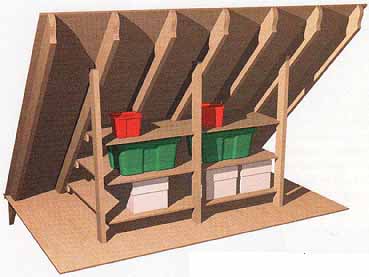Many attics are not usable for storage because they are too small or too congested by insulation, ductwork, plumbing, or roof framing. But steep roofs supported by rafters rather than trusses usually cover some useful storage space.
In thinking about attic storage, space is only the first consideration. You also need adequate access, flooring, and light. Also, most attics are not heated or air-conditioned, so be sure the items you plan to store there can withstand the environment.GAINING ACCESS
The simplest form of attic access is through a push-up hatch, or scuttle, often located in a hallway or closet. Many of these hatches are small, with just enough room for a person to clamber through for maintenance. In these cases, the attic probably wasn’t meant for storage. You’ll need an opening at least 30 inches square for any serious storage utility.
Getting items up through the opening is a concern. You could haul out the step ladder each time and risk breaking your neck as you heft boxes up the ladder and heave them through the hatch. A fixed ladder, mounted on an adjacent wall, offers a sturdier solution. Better yet, fold-down stairs provide handy, easy-to-hide access. Prefabricated units are available at home centers, and installation is not difficult. These stairs don’t waste floor space, they’re invisible when not in use, and good ones are more stable and comfortable than ladders.
A fixed stairway offers far more convenience and stability, but space for
permanent stairs is even harder to find than storage. And stairway construction
is best left to professionals.


Retractable stairway; Ladder; Wall-mounted
ladder; Switchback stairs; Straight-run stairs; Corner stairs
ORGANIZING THE UNFINISHED ATTIC
To maximize storage space in an attic, you must use odd-shaped areas, sharp angles, and limited headroom to the best advantage. In most cases, it isn’t a problem but rather an opportunity to develop ingenious solutions. Generally, an attic has three areas with storage potential: along the sloping walls, against gable ends, and right in the center under the ridge beam. To take advantage of those areas, try these ideas:
• Make sure there is maximum floor space. If floor joists are exposed, cover them with plywood or other flooring. Be careful when applying flooring that you do not compress insulation, which reduces its effectiveness.
• If you live in an area with temperature extremes, consider insulating the roof so the space is not blistering hot in the summer and ice cold in the winter.
• Install vents in the roof, gable, or soffit to keep air moving in the attic.
• Store items off the floor, away from dirt, bugs, and moisture, Discarded shipping pallets are handy if they will fit through your attic access. The attic is the perfect place for old shelving. Garage sales, flea markets, and thrift shops are good sources. Look for units that come apart if you have limited access.
• Don’t store items in rows more than two deep.
• Leave pathways so you can reach everything. The last thing you want is an impenetrable wall of belongings that requires unstacking and stacking in tight quarters.
• Stackable plastic containers seal out dirt, dust, and bugs. If you use cardboard boxes, seal them with tape and mark them so you won’t have to open rows of boxes to find something.
• If you store seasonal hanging clothes, protect them with plastic zip-up garment bags. Cardboard garment boxes sold by moving companies are not as bug proof but will keep dust off your clothes.
Four 2x4s, some 1x3 cleats, and three pieces of ¾-inch plywood (right) or just the plywood and some chain and hardware (bottom center) are all it takes to make some handy shelves in the space below attic rafters. If you hang the shelves with chains, you can attach them in one of three ways:
• Insert screws with washers through the chain links.
• Drill holes through the shelves, slip the chain through the holes, then run a bolt through a chain link.
• Or simply tie a sturdy rope between the chain links and rest the shelf on the rope.

2x4 lumber supports the front of
shelves tied to rafters under attic eaves

Rope supports shelf; Screws through
chain and into shelf edge; Shelves centered under ridge beam, for
maximum height.